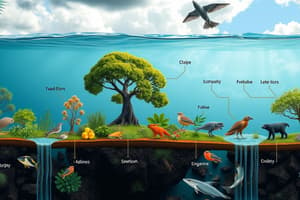Podcast
Questions and Answers
An ______ is a community of living organisms interacting with each other and their non-living environment in a specific area.
An ______ is a community of living organisms interacting with each other and their non-living environment in a specific area.
ecosystem
Energy flow in an ecosystem is typically in the form of ______ energy.
Energy flow in an ecosystem is typically in the form of ______ energy.
food
The ______ Law states that only 10% of energy is transferred from one trophic level to the next.
The ______ Law states that only 10% of energy is transferred from one trophic level to the next.
Ten Percent
The ______ levels refer to the position of a group of organisms in a food chain based on their feeding pattern.
The ______ levels refer to the position of a group of organisms in a food chain based on their feeding pattern.
Trophic levels are important because they maintain the ______ and function of ecosystems.
Trophic levels are important because they maintain the ______ and function of ecosystems.
Decomposers at all levels recycle ______ back into the environment.
Decomposers at all levels recycle ______ back into the environment.
The direction of energy flow in an ecosystem is ______ and follows a unidirectional path.
The direction of energy flow in an ecosystem is ______ and follows a unidirectional path.
The Ten Percent Law was introduced in context to energy flow in ecosystems by ______ Lindeman.
The Ten Percent Law was introduced in context to energy flow in ecosystems by ______ Lindeman.
Flashcards
Ecosystem
Ecosystem
A community of living organisms interacting with their environment.
Energy Flow
Energy Flow
The movement of energy from one organism to another in an ecosystem.
Trophic Levels
Trophic Levels
Positions of organisms in a food chain based on feeding patterns.
10 Percent Law
10 Percent Law
Signup and view all the flashcards
Biotic Components
Biotic Components
Signup and view all the flashcards
Abiotic Components
Abiotic Components
Signup and view all the flashcards
Producers
Producers
Signup and view all the flashcards
Decomposers
Decomposers
Signup and view all the flashcards
Study Notes
Ecosystem
- An ecosystem is a community of living organisms interacting with each other and their non-living environment. These interactions form a system where energy flows and matter cycles to sustain life.
- Ecosystems have biotic components (living things) like plants, animals, and humans and abiotic components (non-living things) like soil, air, and water.
Energy Flow in an Ecosystem
- Energy flow in an ecosystem is the pathway energy takes to move from one organism to another.
- It's a fundamental concept in ecological studies.
- Energy flows in a unidirectional manner.
- Energy transfer typically takes place as food energy from one trophic level to another.
Energy Flow of Ecosystem Diagram
- The diagram shows the flow of energy in an ecosystem.
- The sun provides energy to producers.
- Producers (plants) are consumed by primary consumers (herbivores).
- Primary consumers are consumed by secondary consumers (carnivores/omnivores).
- Secondary consumers may be consumed by tertiary consumers (top carnivores).
- Decomposers break down dead organisms, returning nutrients to the ecosystem.
Ten Percent Law
- This law, introduced by Raymond Lindeman, states that only about 10% of energy is transferred from one trophic level to the next.
- The remaining energy is lost as heat due to metabolic processes.
Trophic Levels
- Trophic levels are the position of organisms in a food chain, food web, or ecological pyramid based on their feeding pattern.
- The positions show a succession of energy flow.
- Most food chains have a maximum of four to five trophic levels.
Trophic Levels Diagram
- The diagram illustrates a pyramid structure showcasing the decrease in biomass (living material) as you move up the trophic levels.
- Quaternary Consumers receive the least amount of energy.
- Producers, at the bottom of the pyramid, receive the most energy from the sun.
Importance of Trophic Levels
- Trophic levels are crucial to maintaining the structure and function of ecosystems.
- They facilitate the flow of energy from producers to apex predators, demonstrating the decrease in energy at each level.
- Each trophic level is connected, building on interdependencies within ecosystems.
- Decomposers recycle nutrients, enabling producers to sustain life and maintain ecological balance.
Studying That Suits You
Use AI to generate personalized quizzes and flashcards to suit your learning preferences.




